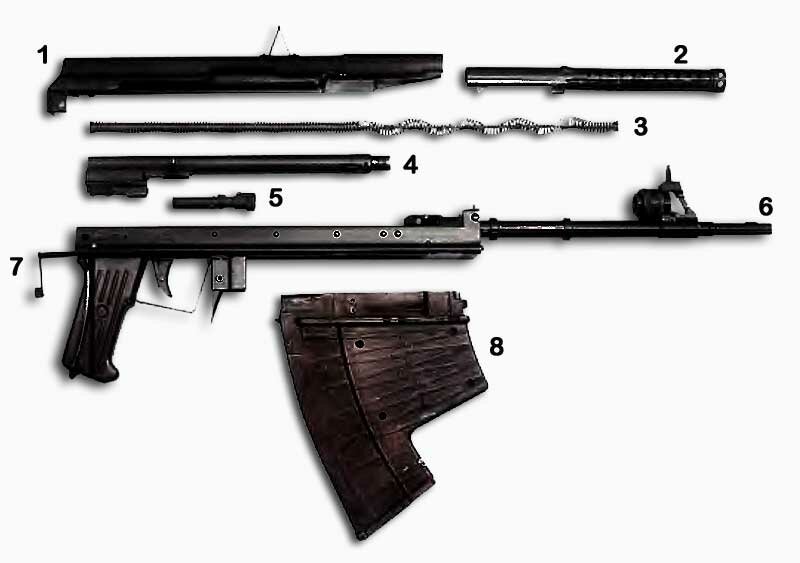APS special purpose underwater assault rifle

| Specifications APS Caliber.....................................................................5,66 mm Cartridge...............................................MPS. MPST (5.66x39) Weight w/o magazine...............................................2,46 kg Weapon length: w/extended stock..................................................840 mm w/removed stock...................................................620 mm Muzzle bullet velocity under the water............340-360 m/sec Muzzle bullet velocity in the air..............................365 m/sec Rate of fire..........................................................600 rds/min Sighting range underwater.......................................10-30 m Sighting range in the air..............................................100 m Magazine capacity........................................................26 rds |
||
The APS assault rifle (special underwater assault rifle) was adopted for service with the USSR Navy in the mid-1970s. The chief designer of this assault rifle was V. V. Simonov from the TSNIITOCHMASH Research Institute. The APS is designed for firing the 5.66x39 type MPS and MPST special rounds with high-elongation bullets (developed by P. F. Sazonov and O. P. Kravchenko). The MPS rounds (with conventional bullet) and MPST (with tracer bullet) are housed in the 5.45x39 standard intermediate cartridge case.
The bullet represents a dart with tapered nose in the form of a double flattened cone: it moves along the barrel bore with a clearance. Such bullet design is determined by specifics of underwater motion which are cardinally different from motion in the air.. When a bullet {or other projectile) is moving through water at high speed, one sees not only changes of incoming flows but also perturbations of flow continuity with cavern forming. In such environment the standard 5.45 mm cartridge bullet for the AK-74 assault rifle with ogival nose and small relative length forms a large-size lateral cavity and topples over very fast. However, if the bullet is made with great elongation (about 20 calibres) and a nose-cone flat face, then it will travel through water in the developed cavitation mode where only its flat face is washed oven which significantly decreases drag and allows forming a cavern of smaller diametre.
Bullet stability in conditions of cavitation is provided by oscillations of the bullet about its nose-cone flat face, caused by interaction between its tail and cavitation bubble walls. In other words, the cavern acts as bullet stabilizer. When the bullet slows down, the cavern also shrinks down in size, and once its rear wall "locks on" the bullet shank, the bullet loses speed drastically, and the cavern "collapses" completely, thus the bullet enters in the mode of "total flooding".
Bullet kill capability depends on diving depth. At depths up to 5 m kill range is 30 m. at a depth of 40 m it is reduced to 10 m. At a range of more than 15 m, accuracy of fire decreases markedly. Yet the MPST cartridge with tracer bullet allows conducting fire corrected by traces.
The weapon has a gas drive with a long-stroke piston and powder gases discharged through the port in the barrel wall: there is also a gas regulator. The breech is Socked by a rotating bolt.
The firing mechanism of the assault rifle is of hammerless type. Shot is performed from the back sear using the energy of a recoil spring. The firing mechanism is assembled in a separate housing and allows single-shot or full-automatic firing; it is equipped with a non-automatic fire selector/safety lever.
Rounds are fed from a detachable box magazine. Due to peculiarities of the cartridge a number of appliances were added to ensure reliable operation of the feed system. Two rows of rounds in the magazine are separated by a plate, and the upper bullets are retained by spring-action catches to prevent their tapping up Inside the receiver, a cartridge cutoff device is installed to prevent cartridge jamming or double feeding.
The stock is of a pull-out type. The assault rifle is adapted for attachment on board underwater vessels.
Production of the APS assault rifles was set up at Tula Armoury Plant. The assault rifle is completed with two magazines and one accessory kit. Until now the APS seems to have no counterparts among foreign series-production weapons.
Although it is possible to fire with the MPS and MPS! rounds "in the air", high-elongation bullets are not. stabilized by rotation and demonstrate poor stability in the air. For aimed fire in the air, ammunition of different type is required.

Field-stripped APS assault rifle: 1 — receiver cover; 2 — gas outlet tube; 3 — back-action spring with gusde rod; 4 — bolt earner; 5 — bold; 6 — barrel with receiver pistol grip and stock; 7 — closer; 8 — magazine.

